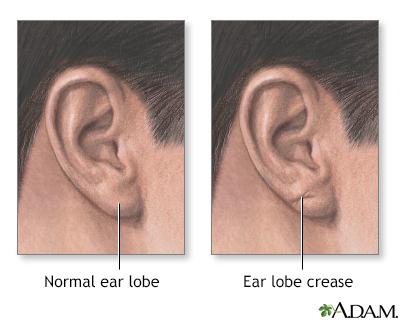Earlobe creases
Earlobe creases are lines in the surface of the earlobe of a child or young adult. The surface is otherwise smooth.
Images

Considerations
The earlobes of children and young adults are normally smooth. Creases are sometimes linked with conditions that are passed down through families. Other genetic factors, such as race and earlobe shape, may also determine who develops earlobe creasing and when it occurs.
It is not uncommon to have one small abnormality in facial features, such as an earlobe crease. Most often, this does not indicate a serious medical condition.
Causes
In children, earlobe creases are sometimes linked with rare disorders. One of these is Beckwith-Wiedemann syndrome.
When to Contact a Medical Professional
In most cases, the health care provider will notice earlobe creases during a regular checkup.
Talk to your provider if you are concerned that your child's earlobe creases may be linked to an inherited disorder.
What to Expect at Your Office Visit
The provider will examine your child and ask questions about medical history and symptoms. These may include:
- When did you first notice the earlobe creases?
- What other symptoms or problems have you also noticed?
Tests depend on the symptoms and appearance of the earlobe creases.
Related Information
Heart attackReferences
Graham JM, Sanchez-Lara PA. Principles of human biomechanics. In: Graham JM, Sanchez-Lara PA, eds. Smith's Recognizable Patterns of Human Deformation. 4th ed. Philadelphia, PA: Elsevier; 2016:chap 51.
Haldeman-Englert CR, Saitta SC, Zackai EH. Chromosome disorders. In: Gleason CA, Juul SE, eds. Avery's Diseases of the Newborn. 10th ed. Philadelphia, PA: Elsevier; 2018:chap 20.
Turnpenny PD, Elard S, Cleaver R. Patterns of inheritance. In: Turnpenny PD, Ellard S, Cleaver R, eds. Emery's Elements of Medical Genetics and Genomics. 16th ed. Philadelphia, PA: Elsevier; 2022:chap 6.
BACK TO TOPReview Date: 10/22/2022
Reviewed By: Charles I. Schwartz, MD, FAAP, Clinical Assistant Professor of Pediatrics, Perelman School of Medicine at the University of Pennsylvania, General Pediatrician at PennCare for Kids, Phoenixville, PA. Also reviewed by David C. Dugdale, MD, Medical Director, Brenda Conaway, Editorial Director, and the A.D.A.M. Editorial team.

Health Content Provider
06/01/2025
|
A.D.A.M., Inc. is accredited by URAC, for Health Content Provider (www.urac.org). URAC's accreditation program is an independent audit to verify that A.D.A.M. follows rigorous standards of quality and accountability. A.D.A.M. is among the first to achieve this important distinction for online health information and services. Learn more about A.D.A.M.'s editorial policy, editorial process and privacy policy. A.D.A.M. is also a founding member of Hi-Ethics. This site complied with the HONcode standard for trustworthy health information from 1995 to 2022, after which HON (Health On the Net, a not-for-profit organization that promoted transparent and reliable health information online) was discontinued. |
The information provided herein should not be used during any medical emergency or for the diagnosis or treatment of any medical condition. A licensed medical professional should be consulted for diagnosis and treatment of any and all medical conditions. Links to other sites are provided for information only -- they do not constitute endorsements of those other sites. © 1997- 2024 A.D.A.M., a business unit of Ebix, Inc. Any duplication or distribution of the information contained herein is strictly prohibited.
